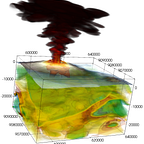Book Title: Sentinel-1 PyGMTSAR (Python InSAR): A Step-by-Step Guide for Everyone. Chapter 1.
Chapter 1: Introduction
Satellite Interferometry: A Brief Overview and Its Applications
Satellite Interferometry, specifically Interferometric Synthetic Aperture Radar (InSAR), is a remote sensing methodology that leverages two or more synthetic aperture radar (SAR) images to create maps of surface deformation or digital elevation models of the terrain. When a satellite emits a radar signal towards Earth, the signal interacts with the surface and reflects back.
Synthetic aperture is a computational technique for continuously transmitting and registering signals, integrating waves received from different points on Earth’s surface. This approach, while increasing complexity in image processing compared to instant snapshots, enhances the resolution of the images. A radar image is computational in nature since it is not captured in a single moment but post-processed from a long-duration measured signal. An interferogram, likewise, is purely computational, created from the phase difference of the return signals from two separate yet nearly identical images.
To achieve nearly identical images, it is necessary to align them perfectly using the well-documented Sentinel-1 satellite orbit to calculate the geometric correction for the minor spatial difference known as the perpendicular baseline. The well-known and easily visible interferogram fringes are the result of phase measurement in the interval 2π, often referred to as wrapped phase. By utilizing continuous unwrapped phase, I can gauge the distance change between the satellite and each point on the ground. This change is partially related to surface deformation, but it also depends on atmospheric conditions and other factors. Essentially, InSAR measures Earth’s surface movements with remarkable precision, often down to a few millimeters or even better over a large series of interferograms.
While generating an interferogram, unwrapping its phase, and even computing Small BAseline Subset (SBAS) displacements are essential steps for extracting knowledge from remote sensing data, they often don’t suffice. These steps are crucial for constructing and analyzing a single interferogram. For example, in the event of large movements such as earthquakes, atmospheric effects and other noise sources can be disregarded. However, these are merely the first strides in a long journey, especially for projects monitoring minute changes, where the noise on the interferograms significantly outweighs the component of surface movements.
Introduction to PyGMTSAR: Purpose and Features
To tackle the practical challenges, PyGMTSAR wraps functions of GMTSAR: InSAR processing system based on GMT and SNAPHU: Statistical-Cost, Network-Flow Algorithm for Phase Unwrapping plus offers the most advanced algorithms for InSAR data processing, including detrending in spatial and frequency domains, seasonal detrending, and more. In the upcoming chapters, I aim to guide you on harnessing the power of PyGMTSAR effectively. This will empower you to extract valuable insights from InSAR data, regardless of your technical background.
Despite its computational intensity and utilization of virtual effects, such as synthetic aperture (which integrates the backscattering wave over time) and interferogram (which represents the phase difference between two aligned images), InSAR can be compared to the principles behind common Wi-Fi or 4G/5G cellular connectivity. These technologies use synthetic aperture antennas and other similar principles while remaining very accessible to end users. PyGMTSAR aims to encapsulate the complexities of InSAR, much like a wireless or cellphone modem. The goal is for users to be able to use the software without delving into technical specifications, just as you would use your cellphone. Similarly, upgrading PyGMTSAR to a new version should be as effortless as switching to a new phone model. As the author of PyGMTSAR, I take care of all the technical details because I can and I love doing it. I strive to make this powerful tool as user-friendly and accessible as possible.
One of the key features of PyGMTSAR is its ability to be used directly on Google Colab with a single click. This means there is no need for local software installation or complex steps to produce results. Live annotated examples are available directly in your web browser, enabling you to change source datasets and processing parameters and see all the results for your own tasks. While this book does not attempt to cover every possible use case for InSAR technology, it offers a curated set of examples that are freely available on the cloud computing platform, Google Colab, and in a Docker image.
Furthermore, it’s possible — and well-documented — to install PyGMTSAR directly on a computer or use it on a cloud host like Amazon and Google Cloud computing instances. This procedure, while outside the scope of this book, is detailed in the PyGMTSAR documentation.
While PyGMTSAR is accessible for everyone and by many ways, it is very powerful software and can work on a huge datasets effectively. Thousands of interferograms for multiple Sentinel-1 scenes stitched together and using high resolution 15 meter can be processed on a common hardware like to Apple Air laptop easily producing hundreds of multigigabyte displacement rasters. That means when you process a long timeseries in SBAS analysis and perform a seasonal trend decomposition and 3D visualization PyGMTSAR works for you well on the same computer as for a single interferogram processing.
